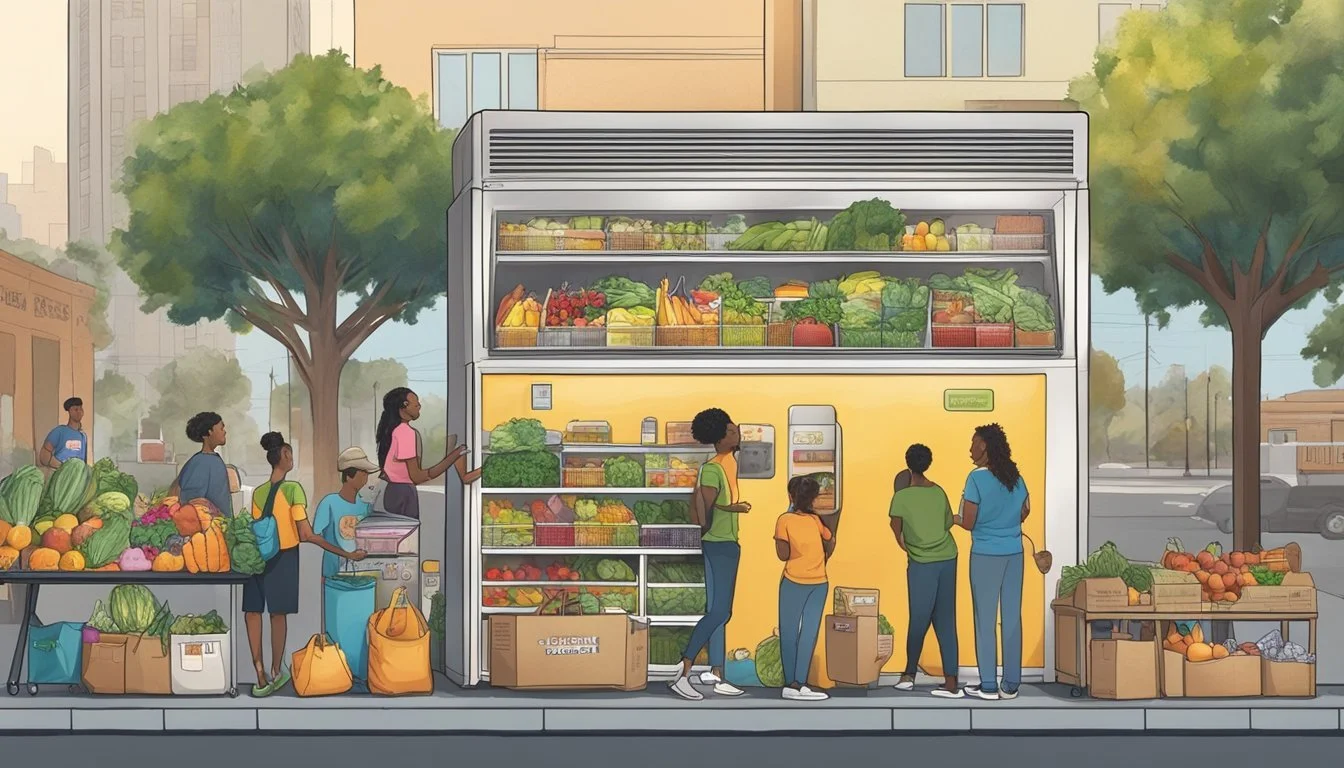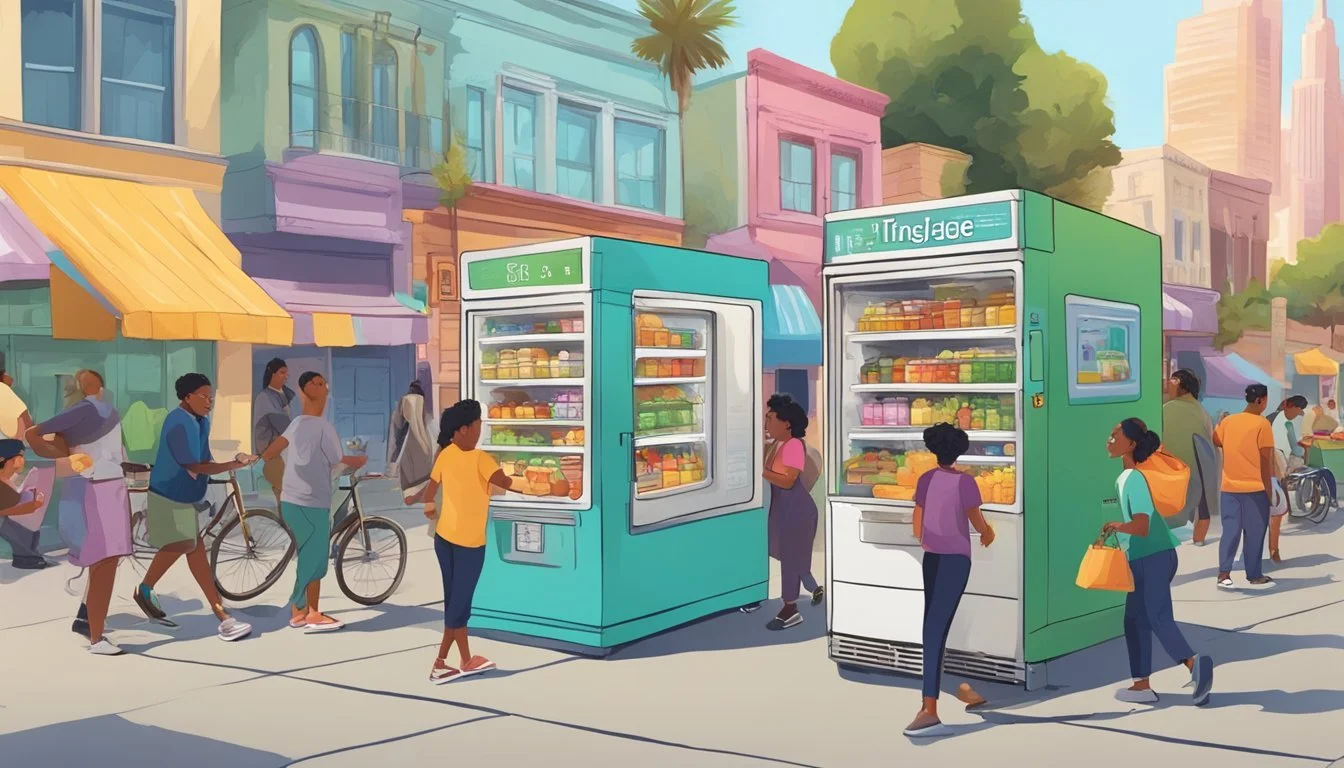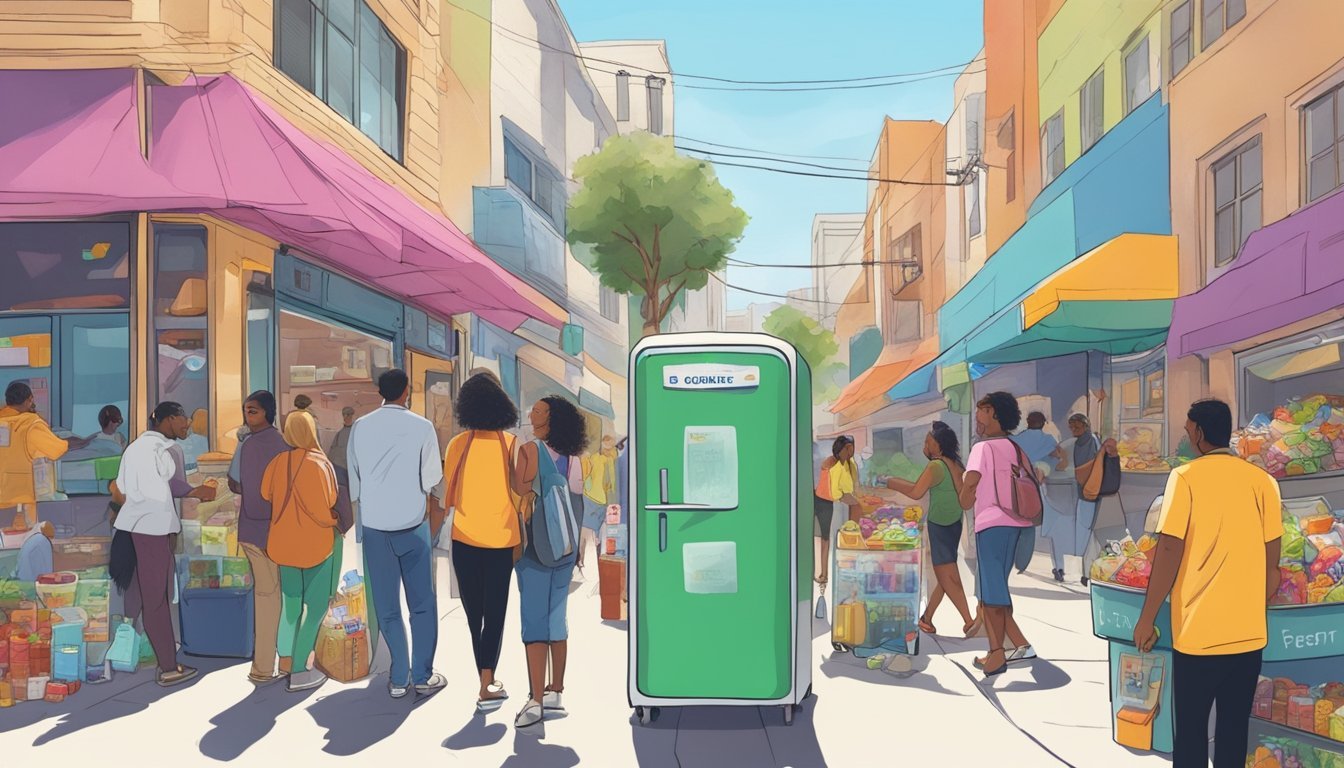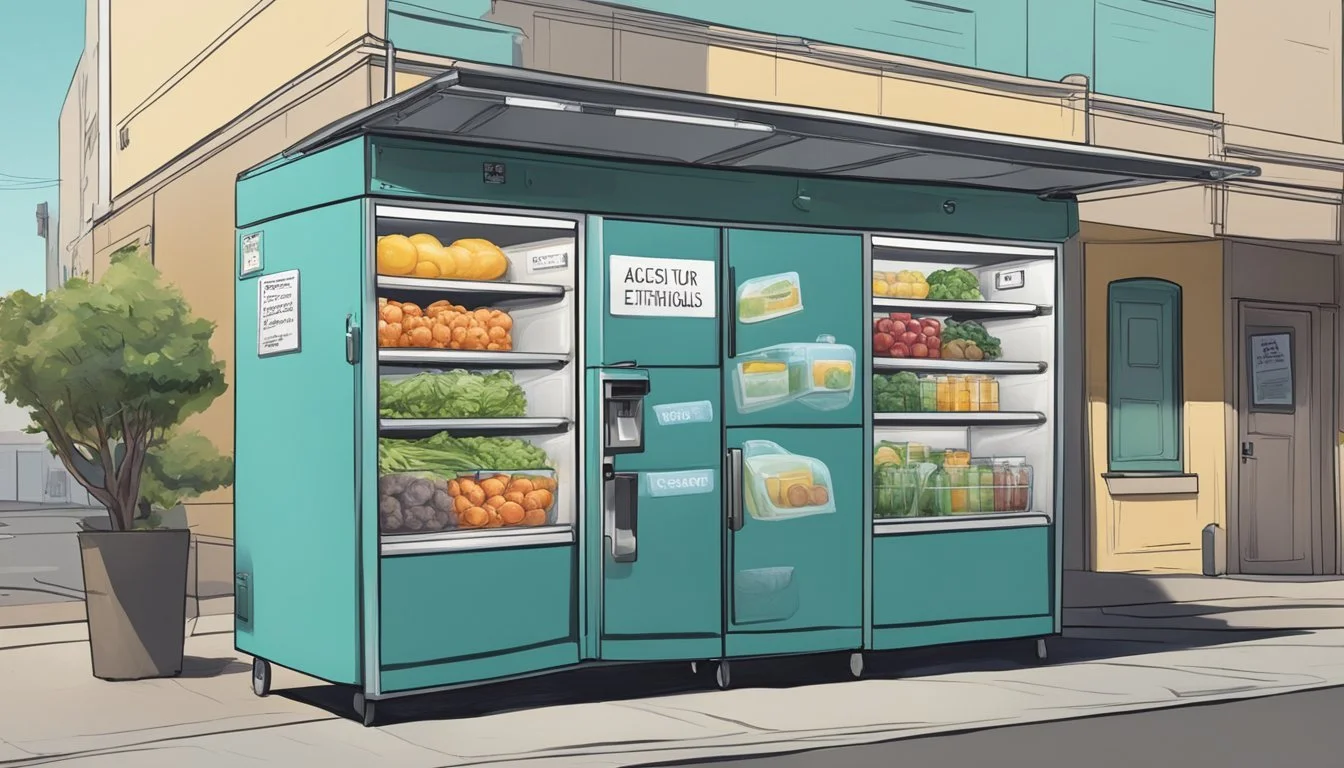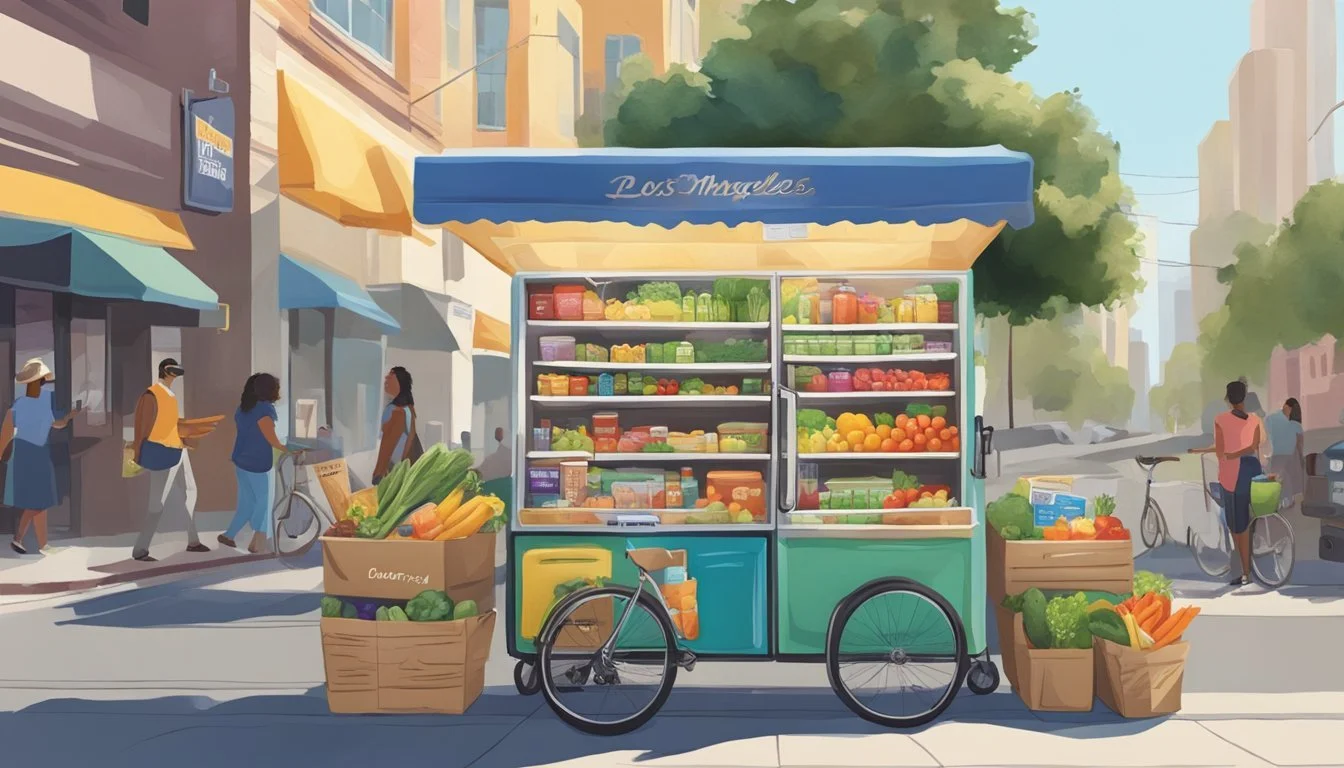Los Angeles, CA Community Fridge
A Beacon of Food Sharing and Support
Los Angeles, California, has become a forerunner in addressing food insecurity through a unique and community-driven solution— the establishment of community fridges. These publicly accessible refrigerators are part of a decentralized network that volunteers power to donate, install, clean, maintain, stock, and use. The fridges are stocked with a variety of items from prepackaged salads to fresh produce and eggs, all free of charge, reflecting an innovative approach to making food available to those who need it.
The Los Angeles Community Fridges initiative is more than a stopgap for hunger; it represents the city's growing commitment to mutual aid and community support systems. Born out of the increased need during the pandemic, this program has seen rapid growth, evolving from a few fridges to a widespread network across different neighborhoods in Los Angeles. These fridges not only offer sustenance but also fortify the connection between residents, local businesses, and organizations, each contributing to the upkeep and supply of the fridges.
This movement aims to combat food scarcity and waste while promoting solidarity within the community. Anyone can contribute to and take from these fridges, which are accessible at any hour, thereby reflecting the city's inclusive spirit. The Los Angeles Community Fridge initiative showcases a community's potential to address systemic issues through collective action and shared responsibility.
Understanding Community Fridges
Community fridges in Los Angeles serve as a tool for food redistribution and a solution to minimize food waste, providing a space for free, accessible food to anyone in need.
Concept and Purpose of Community Fridges
Community fridges are public refrigerators that operate on the principle of "take what you need, leave what you can." These fridges aim to address food insecurity by being stocked with food donations from members of the community. The idea is to create an open-access point for food, where the lack of affordability is not a barrier to nutritional sustenance. These refrigerators work on the goodwill of the community, ensuring that excess food is shared and not wasted, thus also tackling the issue of food waste.
History and Growth in Los Angeles
The movement of LA Community Fridges has seen significant growth. It began as a grassroots initiative with the simple act of placing a single refrigerator in a public space, where people could donate or take food. Over time, the number of fridges expanded across Los Angeles, thanks in part to the support of local businesses and volunteers who provide space and electricity. The network's contribution has extended beyond food redistribution to include maintaining cleanliness and ensuring food safety. The project emphasizes community empowerment and solidarity in the face of hardships, such as food scarcity and financial instability.
Community Fridge Operations
The operations of community fridges in Los Angeles hinge on adherence to regulatory standards, continuous electricity supply, and community involvement. They serve as decentralized points where individuals and families can access food donations, and their effectiveness relies on solid logistical and maintenance frameworks.
How Community Fridges Work
In Los Angeles, community fridges operate on a simple principle: take what you need, leave what you can. They are often placed in accessible locations and are managed by groups of dedicated volunteers. To streamline operations, volunteers oversee the following:
Collection of Donations: Food and essential items are sourced from local businesses, farmers, and residents.
Stocking the Fridges: Items are organized within the fridges to ensure easy access and efficient use of space.
Community Engagement: Outreach efforts help to raise awareness about the locations and purpose of the fridges.
Health and Safety Regulations
Community fridge operations must comply with Los Angeles County health and safety codes to ensure public wellbeing. This includes:
Regular Sanitization: Fringes are cleaned frequently to maintain hygiene.
Quality Checks: All items are checked for expiry dates and signs of spoilage.
Personal Protective Equipment (PPE): Volunteers are required to use gloves and masks during their shifts.
Electricity and Maintenance Considerations
Maintaining a community fridge involves several ongoing considerations to ensure the refrigeration units remain operational:
Steady Electricity Supply: Fridges need a consistent source of electricity to keep food fresh.
Repairs and Upkeep: Regular inspections and maintenance prevent breakdowns and extend the lifespan of the fridges.
Operational Costs: The electricity bills and maintenance expenses are typically covered through community donations and fundraising efforts.
Benefits of Community Fridges
Community fridges in Los Angeles tackle pressing urban challenges by providing free food, promoting sustainability, and encouraging social cohesion. Critical needs are met as these fridges confront food insecurity, minimize waste, and foster unity.
Combating Food Insecurity
Community fridges provide free, accessible food to individuals and families facing food insecurity. With fresh produce and other food items available, these fridges make healthy options more attainable for all, especially for those who might not have the means to purchase such necessities otherwise.
Accessibility: Fridge locations are spread throughout the city, ensuring convenience.
Variety: Offerings often include a mix of produce, pantry staples, and sometimes prepared meals.
Reducing Food Waste
These fridges play a crucial role in reducing food waste by allowing residents to donate surplus food. Not only does this practice divert food from landfills, but it also ensures that edible food reaches those who need it.
Sustainability: Less food waste contributes to environmental efforts.
Efficiency: Food is quickly cycled through, with little going unused.
Strengthening Community Bonds
Community fridges are a testament to mutual aid and the spirit of sharing. They become social hubs where people can contribute to the welfare of their neighbors, thus strengthening community bonds.
Mutual Aid: Individuals support each other, demonstrating communal resilience.
Inclusivity: The open-access nature of these fridges fosters a sense of belonging and togetherness.
Los Angeles Community Fridge Locations
Los Angeles hosts a network of community fridges designed to combat food insecurity and reduce waste. Various neighborhoods, including Mid-City, Highland Park, and East Hollywood, have established fridge locations to serve residents.
Mid-City Community Fridge
The Mid-City Community Fridge can be found in the heart of Los Angeles, providing an accessible location for residents to donate and obtain food. This fridge champions the fight against food scarcity in the area and stands as a testament to community solidarity.
Highland Park Community Fridge
In Highland Park, the community fridge serves as a hub for fresh food distribution. Nestled within this lively and historic Los Angeles neighborhood, the fridge aids in nurturing the local community and mitigating hunger.
East Hollywood Community Fridge
The East Hollywood Community Fridge is strategically located to support one of the city's most diverse communities. It offers a vital resource for those facing food insecurity and encourages communal sharing and support.
Maps are available for those seeking to locate these fridges across Los Angeles, with clear signage indicating where people can contribute food or find sustenance.
Community Engagement and Support
The success of the Los Angeles Community Fridge initiative hinges on robust community engagement, with local businesses, organizations, and individual volunteers playing pivotal roles. The movement has also leveraged social media effectively to increase community awareness and participation.
Volunteer Opportunities
Volunteers are the backbone of the LA Community Fridge project. They contribute by cleaning and maintaining the fridges, restocking food supplies, and coordinating efforts within neighborhoods. Individuals looking to support can find opportunities ranging from one-time assistance to regular involvement in ensuring the fridges are functional and well-utilized.
Local Businesses and Organizations Involved
Several local businesses and organizations have stepped up to partner with the LA Community Fridge network. These entities often provide space for the fridges, donate surplus food, and assist in the logistics of running and maintaining each site. Restaurants, in particular, have found participating in the fridge program to be a practical way to contribute to their communities sustainably.
Social Media and Community Awareness
Social media plays a critical role in spreading awareness of the community fridges. Instagram posts often feature vibrant photos of the fridges, updates on food availability, and shoutouts to supporters. This online visibility encourages neighbors to both contribute to and benefit from the fridges, creating a cycle of mutual aid that strengthens community bonds.
Contributions and Donations
The LA Community Fridges initiative relies on generous contributions and donations of various items to support those in need. These donations help stock the multiple fridges across Los Angeles, providing easy access to essential supplies for the local community.
Types of Acceptable Donations
LA Community Fridges encourages donations of the following items:
Fresh Food: Donors may contribute fruits, vegetables, and other perishable items that are still within their freshness.
Canned Goods: Non-perishable items like canned vegetables, fruits, and other canned food products are welcomed.
Dairy Products: Sealed dairy items such as milk and eggs are accepted, provided that they are within their expiration date.
Hygiene Products: Unopened hygiene items, including soaps and sanitary goods, are crucial for health and dignity.
All items should be unexpired and safe for consumption or use.
How to Safely Donate
To ensure a safe donation process, individuals should follow these guidelines:
Check Quality: Make sure all perishable items like produce, eggs, and milk are fresh and unspoiled. Non-perishables should not be dented or rusted.
Sealed and Packaged: Donations should be in their original, sealed packaging to maintain hygiene and health standards.
Cleanliness: Clean the exterior of canned goods and other sealed items to reduce any potential transmission of contaminants.
These practices ensure that the support provided through donations maintains the highest level of safety and respect for community members in need.
Challenges and Solutions
In addressing the issue of food insecurity in Los Angeles, community fridges offer a grassroots solution, but they face various challenges. Their sustainability, protection from vandalism, and the need for community trust and participation are crucial to their ongoing success.
Vandalism and Theft
Community fridges often become targets for vandalism and theft. Some instances of vandalism could be deterred by strategic placement and surveillance. Community members can collaboratively monitor these fridges, which increases security and fosters a sense of collective ownership. Providing clear guidelines on fridge usage can also mitigate misappropriation of resources.
Sustainability Issues
The sustainability of community fridges relies on consistent donations and efficient management. Maintaining regular contributions requires community involvement, awareness campaigns, and partnerships with local businesses. Similarly, using solar-powered refrigerators could be a solution for energy sustainability concerns.
Community Trust and Participation
Trust and participation from the community are vital for the success of community fridges. To nurture trust, organizers can engage directly with local residents through events and educational initiatives. One approach is to involve community leaders who can facilitate awareness and encourage sustained participation. Establishing a transparent management system ensures that community members feel their contributions are valued and properly utilized.
Impact of the Pandemic on Community Fridges
The COVID-19 pandemic significantly altered the operations of community fridges in Los Angeles by increasing demand for free food and necessitating enhanced safety measures.
Shift in Demand for Free Food
During the pandemic, Los Angeles community fridges faced a surge in demand. The economic fallout led to higher rates of food insecurity, with many residents losing their income and turning to mutual aid networks for assistance. Community fridges served as a critical resource by providing access to free, fresh food for families in need. The items most commonly sought included:
Fruit
Vegetables
Chicken
The fridges not only offered sustenance but also solidarity within the community, affirming a shared commitment to supporting one another through hardship.
Safety Precautions During Covid
In response to COVID-19, operators of community fridges implemented strict safety precautions to minimize risks. They advised donors and recipients to adhere to the following guidelines:
Wear PPE (masks and gloves) when interacting with the fridge.
Sanitize hands before and after fridge use.
Regularly clean the fridge surfaces to prevent contamination.
These measures aimed to ensure that the fridges remained safe and continued to be a reliable food source for the community. The emphasis on safety helped maintain trust in and utilization of the community fridges throughout the pandemic.
Case Studies
The following case studies illustrate the positive impact of community fridges in Los Angeles, highlighting specific initiatives and their contributions to the local culture and community sustenance.
Little Amsterdam Coffee Shop Fridge
Little Amsterdam Coffee Shop in Southern California has become a focal point of the community fridge movement in Los Angeles. Joshua Mock, owner of the coffee shop, has hosted a refrigerator that not only provides food to those in need but also serves as a canvas for local culture. Renowned artist Mary A. Harris was commissioned to paint a mural on the fridge, elevating it from a mere food storage appliance to a piece of community art that both reflects and enhances the vibrant local culture.
Play Nice LBC's Initiative
In the neighboring city of Long Beach, Play Nice LBC is spearheading their initiative to combat food insecurity. They've strategically placed their community fridge to serve as a nexus for mutual support within the city. This initiative has been particularly significant in Southern California, where many residents face economic disparities. The fridge is stocked by the community and serves as an open resource for anyone in need, embodying the spirit of communal care and cooperation that characterizes the broader community fridge movement.
Legal and Ethical Considerations
Los Angeles' community fridge initiatives operate within a complex landscape of legal and regulatory frameworks. They often grapple with questions pertaining to food safety, liability, and municipal regulations. These fridges, which are typically managed by volunteer networks, aim to address food insecurity ethically by providing free access to fresh foods, thus they must balance benevolent intentions with legal compliance.
Liability issues are of particular concern. Organizers must consider both the California Retail Food Code and local health department standards to ensure the safety of the food distributed. The fridges need to be registered and may require frequent inspections. Furthermore, the Bill Emerson Good Samaritan Food Donation Act provides a federal layer of protection against liability for donors, as long as donations are made in good faith.
On an ethical front, the community fridges emphasize respect for users' dignity, offering sustenance without prerequisite qualifiers, thus honoring anonymity and self-service. They embody a mutual aid ethos, diverging from charity, highlighting community self-sustenance. Non-profit status may be sought by some groups to facilitate donations and operations.
In practice, these community fridges must navigate the overlapping jurisdictions of public health laws, zoning codes, and other municipal regulations. They collaborate with legal experts to adapt and conform to the nuances of these regulations, ensuring their services remain uninterrupted and beneficiaries can rely on them consistently.
Food Safety: Regular cleaning and maintenance schedules.
Legal: Adherence to state and local food distribution laws.
Ethical: Ensuring dignified access to all users.
Non-Profit Considerations: May include formalizing structures or partnerships for sustainability.
Legal and ethical considerations remain a priority for those operating community fridges in Los Angeles, not simply to maintain operations but to serve the community responsibly and sustainably.
Future Directions and Growth
The Los Angeles Community Fridge initiative is poised for significant growth and expansion. Key to this development is the establishment of new fridge locations and forging partnerships with local food banks and pantries.
Expanding the Network of Community Fridges
Los Angeles has witnessed a promising increase in community fridges, aiming to reach more neighborhoods and further alleviate food insecurity. This growth trajectory suggests the potential establishment of fridges in Long Beach and other surrounding areas, thereby extending the initiative's outreach. The main objectives include:
Identifying strategic locations: Selection driven by community needs and accessibility.
Securing sustainable resources: Ensuring a continuous supply of fresh produce and staples.
Collaborations with Food Banks and Pantries
To provide a more robust support network, the Los Angeles Community Fridge organizers are actively pursuing collaboration with established food assistance organizations like the LA Food Bank. These partnerships could lead to:
Resource sharing: Combining efforts to optimize food distribution.
Joint community programs: Launching targeted initiatives to reach the top tiers of food security.
By maintaining a clear and neutral stance, the project seeks to harness growth opportunities and foster a future where every individual in the Los Angeles area has access to the nourishment they need.
How to Get Involved
Getting involved with the Los Angeles Community Fridge initiative is an excellent way for individuals to actively participate in a grassroots effort aimed at combating food insecurity. One can start a new community fridge, support existing ones, or help spread the word about this mutual aid network.
Starting a Community Fridge
Starting a community fridge requires careful consideration and coordination. Individuals interested in placing a new fridge should:
Contact the Los Angeles Community Fridges (LACF) to express interest and receive guidelines for establishment.
Secure a location that is accessible and visible to the community.
Ensure there is consistent electrical access and commitment from a host to maintain the site.
Organize a group of volunteers to regularly check and clean the fridge.
It is crucial that new fridges comply with local health and safety regulations to ensure the well-being of everyone who uses them.
Supporting Existing Fridges
In order to support existing free-food fridges, volunteers can:
Donate food by following the donation guidelines set forth by LACF, mainly focusing on fresh and nutritious items.
Contribute through regular cleaning and maintenance tasks.
Monitor inventory levels and ensure that the fridge is well-stocked and organized.
Those unable to donate time or resources can also support through financial contributions to help cover operational costs such as electricity and repairs.
Spreading the Word
Raising awareness is as valuable as physical contributions. To spread the word:
Utilize social media platforms to share locations and needs of community fridges.
Engage in community events to inform local residents about the availability and purpose of the fridges.
Partner with local businesses and organizations that might be interested in supporting this cause.
By communicating the mission of community fridges, more people can become both contributors and beneficiaries of this mutual aid network.

